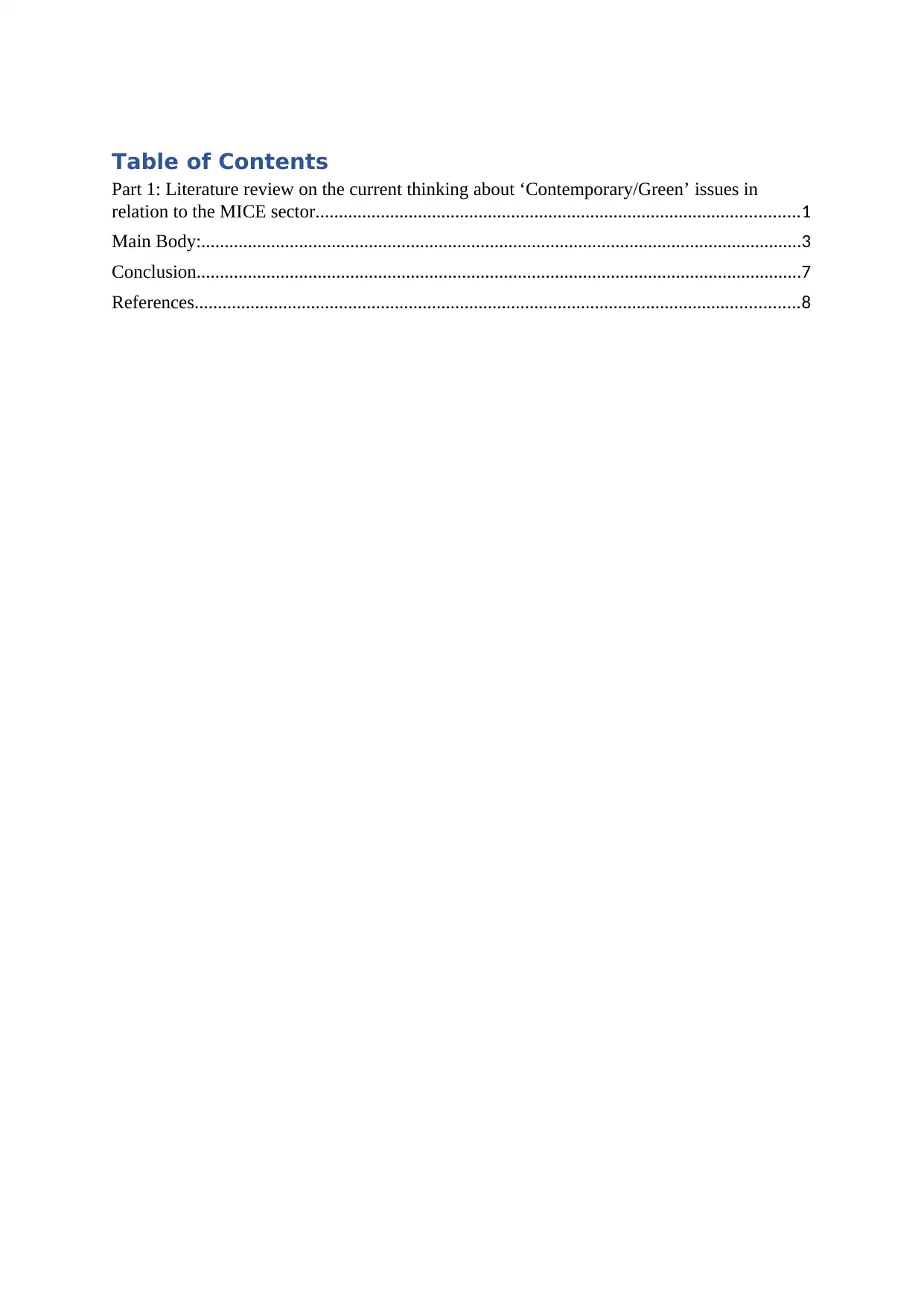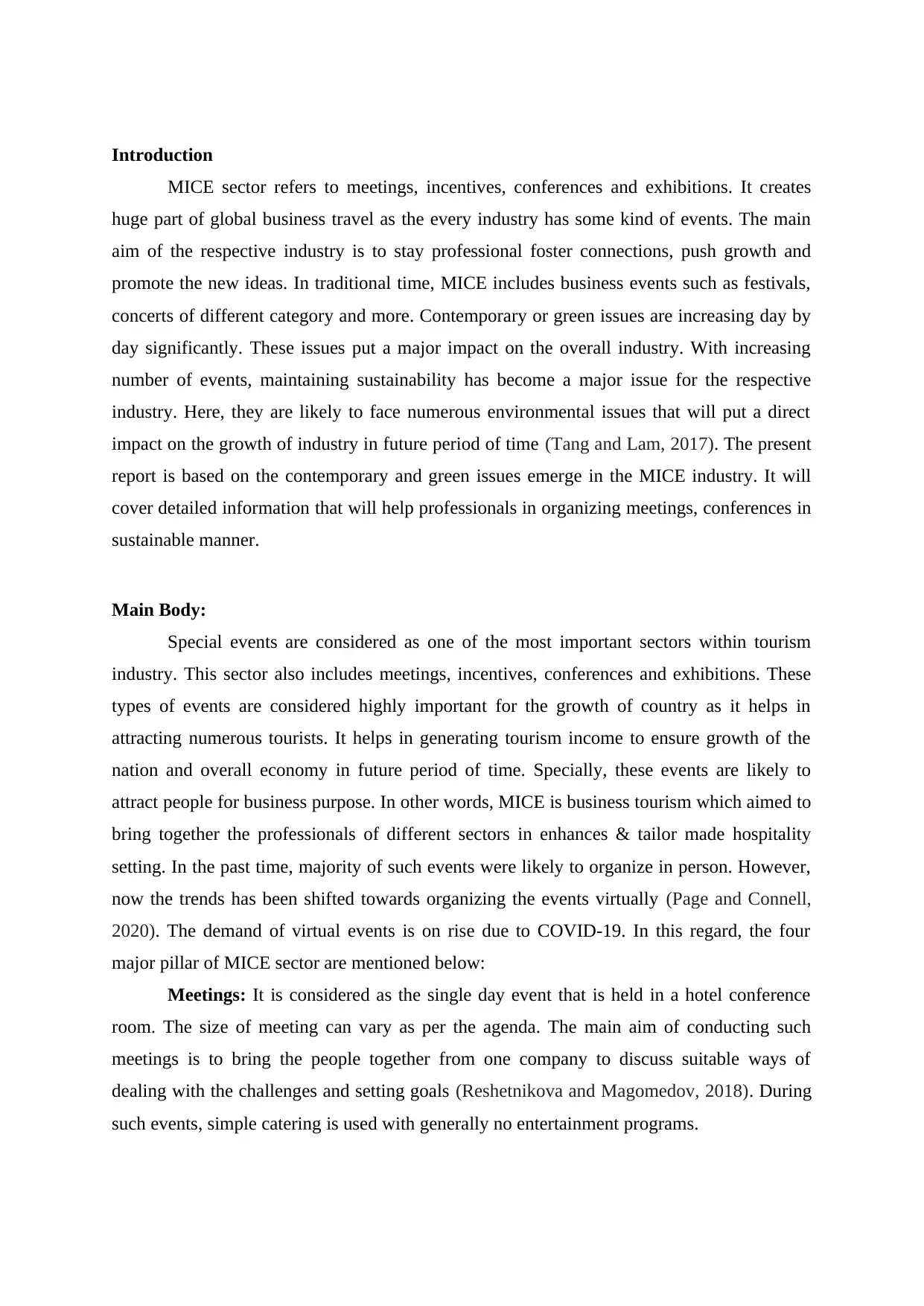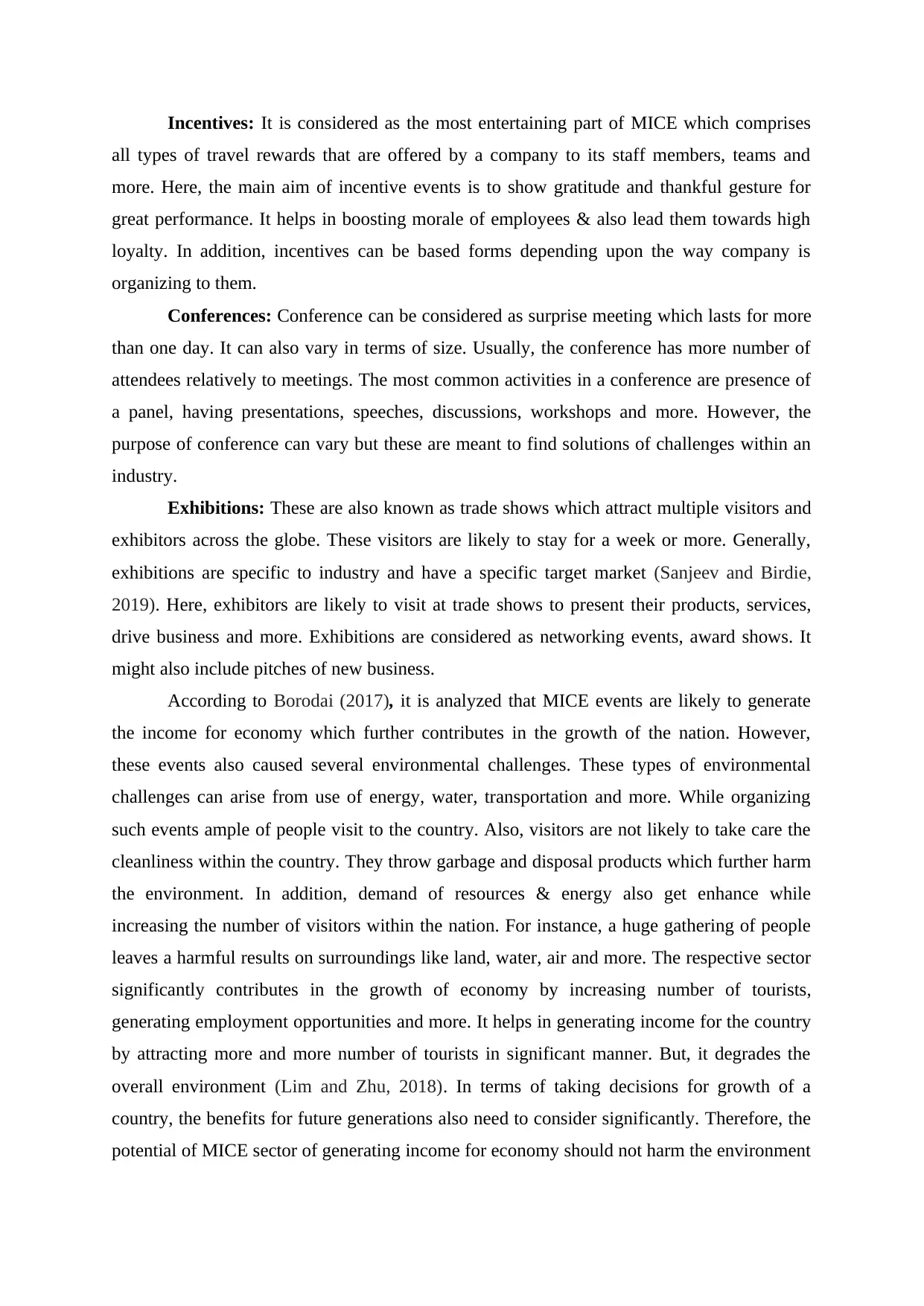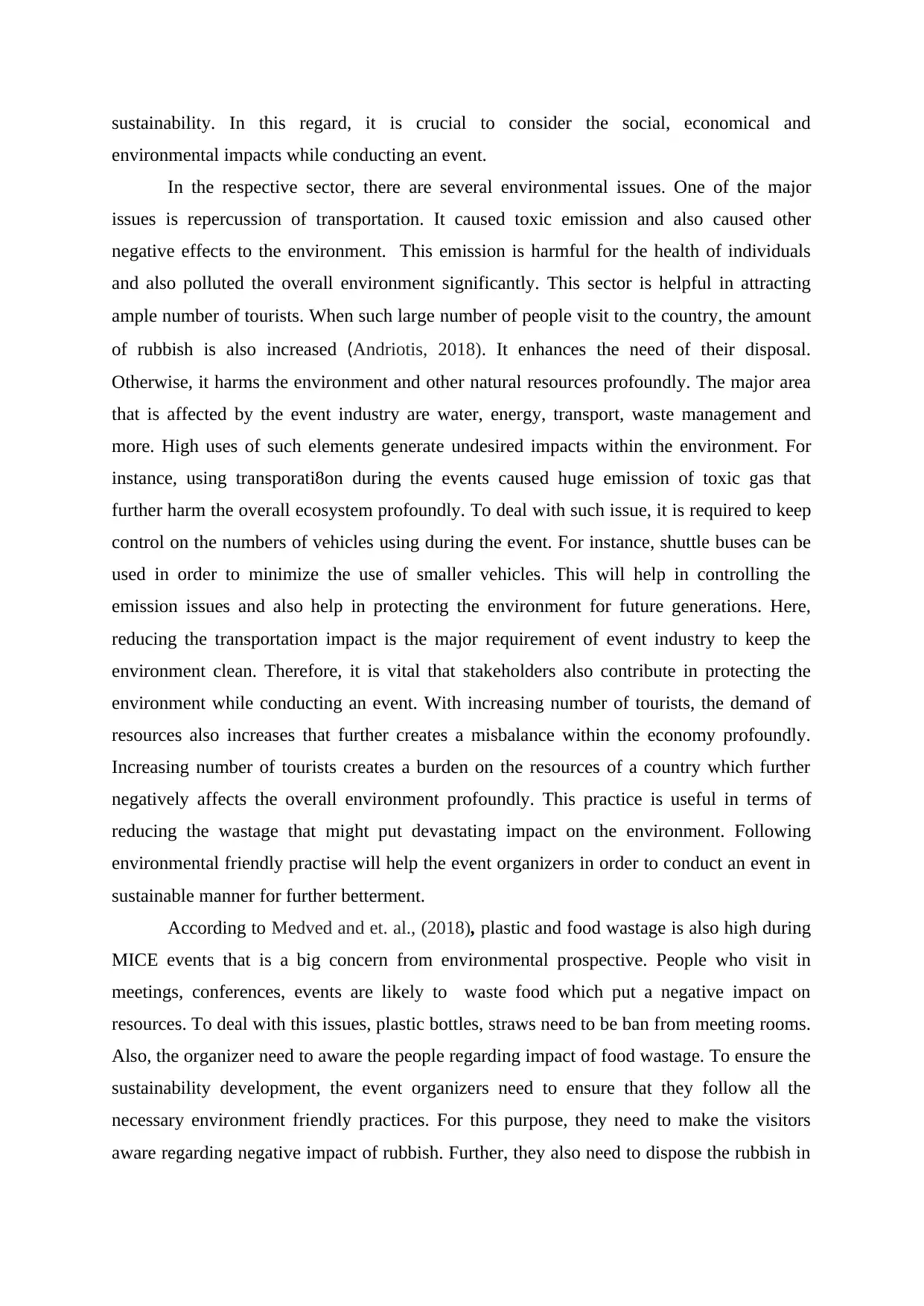Contemporary/Green Issues in MICE Sector: Literature Review Report
VerifiedAdded on 2023/06/08
|8
|2022
|199
Report
AI Summary
This report provides a literature review of contemporary and green issues within the Meetings, Incentives, Conferences, and Exhibitions (MICE) sector. It examines the environmental impacts of MICE events, including transportation emissions, waste management, and resource consumption. The report discusses the importance of sustainability, emphasizing the need for event organizers to adopt environmentally friendly practices to mitigate negative impacts and ensure long-term economic growth. It highlights issues such as plastic and food waste, and suggests strategies to minimize them, such as banning plastic and educating attendees about waste reduction. The report concludes by stressing the importance of stakeholder collaboration in promoting sustainable development within the MICE sector, contributing to both economic growth and environmental protection. The MICE sector's contribution to the economy and the need for sustainable practices are central themes.

Meetings, Incentives, Conferences and Exhibitions
Project Report:
Part 1: Literature review on the current thinking about ‘Contemporary/Green’ issues
in relation to the MICE sector.
Project Report:
Part 1: Literature review on the current thinking about ‘Contemporary/Green’ issues
in relation to the MICE sector.
Paraphrase This Document
Need a fresh take? Get an instant paraphrase of this document with our AI Paraphraser

Table of Contents
Part 1: Literature review on the current thinking about ‘Contemporary/Green’ issues in
relation to the MICE sector........................................................................................................1
Main Body:.................................................................................................................................3
Conclusion..................................................................................................................................7
References..................................................................................................................................8
Part 1: Literature review on the current thinking about ‘Contemporary/Green’ issues in
relation to the MICE sector........................................................................................................1
Main Body:.................................................................................................................................3
Conclusion..................................................................................................................................7
References..................................................................................................................................8

Introduction
MICE sector refers to meetings, incentives, conferences and exhibitions. It creates
huge part of global business travel as the every industry has some kind of events. The main
aim of the respective industry is to stay professional foster connections, push growth and
promote the new ideas. In traditional time, MICE includes business events such as festivals,
concerts of different category and more. Contemporary or green issues are increasing day by
day significantly. These issues put a major impact on the overall industry. With increasing
number of events, maintaining sustainability has become a major issue for the respective
industry. Here, they are likely to face numerous environmental issues that will put a direct
impact on the growth of industry in future period of time (Tang and Lam, 2017). The present
report is based on the contemporary and green issues emerge in the MICE industry. It will
cover detailed information that will help professionals in organizing meetings, conferences in
sustainable manner.
Main Body:
Special events are considered as one of the most important sectors within tourism
industry. This sector also includes meetings, incentives, conferences and exhibitions. These
types of events are considered highly important for the growth of country as it helps in
attracting numerous tourists. It helps in generating tourism income to ensure growth of the
nation and overall economy in future period of time. Specially, these events are likely to
attract people for business purpose. In other words, MICE is business tourism which aimed to
bring together the professionals of different sectors in enhances & tailor made hospitality
setting. In the past time, majority of such events were likely to organize in person. However,
now the trends has been shifted towards organizing the events virtually (Page and Connell,
2020). The demand of virtual events is on rise due to COVID-19. In this regard, the four
major pillar of MICE sector are mentioned below:
Meetings: It is considered as the single day event that is held in a hotel conference
room. The size of meeting can vary as per the agenda. The main aim of conducting such
meetings is to bring the people together from one company to discuss suitable ways of
dealing with the challenges and setting goals (Reshetnikova and Magomedov, 2018). During
such events, simple catering is used with generally no entertainment programs.
MICE sector refers to meetings, incentives, conferences and exhibitions. It creates
huge part of global business travel as the every industry has some kind of events. The main
aim of the respective industry is to stay professional foster connections, push growth and
promote the new ideas. In traditional time, MICE includes business events such as festivals,
concerts of different category and more. Contemporary or green issues are increasing day by
day significantly. These issues put a major impact on the overall industry. With increasing
number of events, maintaining sustainability has become a major issue for the respective
industry. Here, they are likely to face numerous environmental issues that will put a direct
impact on the growth of industry in future period of time (Tang and Lam, 2017). The present
report is based on the contemporary and green issues emerge in the MICE industry. It will
cover detailed information that will help professionals in organizing meetings, conferences in
sustainable manner.
Main Body:
Special events are considered as one of the most important sectors within tourism
industry. This sector also includes meetings, incentives, conferences and exhibitions. These
types of events are considered highly important for the growth of country as it helps in
attracting numerous tourists. It helps in generating tourism income to ensure growth of the
nation and overall economy in future period of time. Specially, these events are likely to
attract people for business purpose. In other words, MICE is business tourism which aimed to
bring together the professionals of different sectors in enhances & tailor made hospitality
setting. In the past time, majority of such events were likely to organize in person. However,
now the trends has been shifted towards organizing the events virtually (Page and Connell,
2020). The demand of virtual events is on rise due to COVID-19. In this regard, the four
major pillar of MICE sector are mentioned below:
Meetings: It is considered as the single day event that is held in a hotel conference
room. The size of meeting can vary as per the agenda. The main aim of conducting such
meetings is to bring the people together from one company to discuss suitable ways of
dealing with the challenges and setting goals (Reshetnikova and Magomedov, 2018). During
such events, simple catering is used with generally no entertainment programs.
⊘ This is a preview!⊘
Do you want full access?
Subscribe today to unlock all pages.

Trusted by 1+ million students worldwide

Incentives: It is considered as the most entertaining part of MICE which comprises
all types of travel rewards that are offered by a company to its staff members, teams and
more. Here, the main aim of incentive events is to show gratitude and thankful gesture for
great performance. It helps in boosting morale of employees & also lead them towards high
loyalty. In addition, incentives can be based forms depending upon the way company is
organizing to them.
Conferences: Conference can be considered as surprise meeting which lasts for more
than one day. It can also vary in terms of size. Usually, the conference has more number of
attendees relatively to meetings. The most common activities in a conference are presence of
a panel, having presentations, speeches, discussions, workshops and more. However, the
purpose of conference can vary but these are meant to find solutions of challenges within an
industry.
Exhibitions: These are also known as trade shows which attract multiple visitors and
exhibitors across the globe. These visitors are likely to stay for a week or more. Generally,
exhibitions are specific to industry and have a specific target market (Sanjeev and Birdie,
2019). Here, exhibitors are likely to visit at trade shows to present their products, services,
drive business and more. Exhibitions are considered as networking events, award shows. It
might also include pitches of new business.
According to Borodai (2017), it is analyzed that MICE events are likely to generate
the income for economy which further contributes in the growth of the nation. However,
these events also caused several environmental challenges. These types of environmental
challenges can arise from use of energy, water, transportation and more. While organizing
such events ample of people visit to the country. Also, visitors are not likely to take care the
cleanliness within the country. They throw garbage and disposal products which further harm
the environment. In addition, demand of resources & energy also get enhance while
increasing the number of visitors within the nation. For instance, a huge gathering of people
leaves a harmful results on surroundings like land, water, air and more. The respective sector
significantly contributes in the growth of economy by increasing number of tourists,
generating employment opportunities and more. It helps in generating income for the country
by attracting more and more number of tourists in significant manner. But, it degrades the
overall environment (Lim and Zhu, 2018). In terms of taking decisions for growth of a
country, the benefits for future generations also need to consider significantly. Therefore, the
potential of MICE sector of generating income for economy should not harm the environment
all types of travel rewards that are offered by a company to its staff members, teams and
more. Here, the main aim of incentive events is to show gratitude and thankful gesture for
great performance. It helps in boosting morale of employees & also lead them towards high
loyalty. In addition, incentives can be based forms depending upon the way company is
organizing to them.
Conferences: Conference can be considered as surprise meeting which lasts for more
than one day. It can also vary in terms of size. Usually, the conference has more number of
attendees relatively to meetings. The most common activities in a conference are presence of
a panel, having presentations, speeches, discussions, workshops and more. However, the
purpose of conference can vary but these are meant to find solutions of challenges within an
industry.
Exhibitions: These are also known as trade shows which attract multiple visitors and
exhibitors across the globe. These visitors are likely to stay for a week or more. Generally,
exhibitions are specific to industry and have a specific target market (Sanjeev and Birdie,
2019). Here, exhibitors are likely to visit at trade shows to present their products, services,
drive business and more. Exhibitions are considered as networking events, award shows. It
might also include pitches of new business.
According to Borodai (2017), it is analyzed that MICE events are likely to generate
the income for economy which further contributes in the growth of the nation. However,
these events also caused several environmental challenges. These types of environmental
challenges can arise from use of energy, water, transportation and more. While organizing
such events ample of people visit to the country. Also, visitors are not likely to take care the
cleanliness within the country. They throw garbage and disposal products which further harm
the environment. In addition, demand of resources & energy also get enhance while
increasing the number of visitors within the nation. For instance, a huge gathering of people
leaves a harmful results on surroundings like land, water, air and more. The respective sector
significantly contributes in the growth of economy by increasing number of tourists,
generating employment opportunities and more. It helps in generating income for the country
by attracting more and more number of tourists in significant manner. But, it degrades the
overall environment (Lim and Zhu, 2018). In terms of taking decisions for growth of a
country, the benefits for future generations also need to consider significantly. Therefore, the
potential of MICE sector of generating income for economy should not harm the environment
Paraphrase This Document
Need a fresh take? Get an instant paraphrase of this document with our AI Paraphraser

sustainability. In this regard, it is crucial to consider the social, economical and
environmental impacts while conducting an event.
In the respective sector, there are several environmental issues. One of the major
issues is repercussion of transportation. It caused toxic emission and also caused other
negative effects to the environment. This emission is harmful for the health of individuals
and also polluted the overall environment significantly. This sector is helpful in attracting
ample number of tourists. When such large number of people visit to the country, the amount
of rubbish is also increased (Andriotis, 2018). It enhances the need of their disposal.
Otherwise, it harms the environment and other natural resources profoundly. The major area
that is affected by the event industry are water, energy, transport, waste management and
more. High uses of such elements generate undesired impacts within the environment. For
instance, using transporati8on during the events caused huge emission of toxic gas that
further harm the overall ecosystem profoundly. To deal with such issue, it is required to keep
control on the numbers of vehicles using during the event. For instance, shuttle buses can be
used in order to minimize the use of smaller vehicles. This will help in controlling the
emission issues and also help in protecting the environment for future generations. Here,
reducing the transportation impact is the major requirement of event industry to keep the
environment clean. Therefore, it is vital that stakeholders also contribute in protecting the
environment while conducting an event. With increasing number of tourists, the demand of
resources also increases that further creates a misbalance within the economy profoundly.
Increasing number of tourists creates a burden on the resources of a country which further
negatively affects the overall environment profoundly. This practice is useful in terms of
reducing the wastage that might put devastating impact on the environment. Following
environmental friendly practise will help the event organizers in order to conduct an event in
sustainable manner for further betterment.
According to Medved and et. al., (2018), plastic and food wastage is also high during
MICE events that is a big concern from environmental prospective. People who visit in
meetings, conferences, events are likely to waste food which put a negative impact on
resources. To deal with this issues, plastic bottles, straws need to be ban from meeting rooms.
Also, the organizer need to aware the people regarding impact of food wastage. To ensure the
sustainability development, the event organizers need to ensure that they follow all the
necessary environment friendly practices. For this purpose, they need to make the visitors
aware regarding negative impact of rubbish. Further, they also need to dispose the rubbish in
environmental impacts while conducting an event.
In the respective sector, there are several environmental issues. One of the major
issues is repercussion of transportation. It caused toxic emission and also caused other
negative effects to the environment. This emission is harmful for the health of individuals
and also polluted the overall environment significantly. This sector is helpful in attracting
ample number of tourists. When such large number of people visit to the country, the amount
of rubbish is also increased (Andriotis, 2018). It enhances the need of their disposal.
Otherwise, it harms the environment and other natural resources profoundly. The major area
that is affected by the event industry are water, energy, transport, waste management and
more. High uses of such elements generate undesired impacts within the environment. For
instance, using transporati8on during the events caused huge emission of toxic gas that
further harm the overall ecosystem profoundly. To deal with such issue, it is required to keep
control on the numbers of vehicles using during the event. For instance, shuttle buses can be
used in order to minimize the use of smaller vehicles. This will help in controlling the
emission issues and also help in protecting the environment for future generations. Here,
reducing the transportation impact is the major requirement of event industry to keep the
environment clean. Therefore, it is vital that stakeholders also contribute in protecting the
environment while conducting an event. With increasing number of tourists, the demand of
resources also increases that further creates a misbalance within the economy profoundly.
Increasing number of tourists creates a burden on the resources of a country which further
negatively affects the overall environment profoundly. This practice is useful in terms of
reducing the wastage that might put devastating impact on the environment. Following
environmental friendly practise will help the event organizers in order to conduct an event in
sustainable manner for further betterment.
According to Medved and et. al., (2018), plastic and food wastage is also high during
MICE events that is a big concern from environmental prospective. People who visit in
meetings, conferences, events are likely to waste food which put a negative impact on
resources. To deal with this issues, plastic bottles, straws need to be ban from meeting rooms.
Also, the organizer need to aware the people regarding impact of food wastage. To ensure the
sustainability development, the event organizers need to ensure that they follow all the
necessary environment friendly practices. For this purpose, they need to make the visitors
aware regarding negative impact of rubbish. Further, they also need to dispose the rubbish in

proper way so it can be used further. This will minimize the burden over resources and will
help them in making optimum use of available resources to ensure sustainable development
in future. In addition, fine should also be imposed on such people who do not follow the
rules. This will help in effective implementation of policies.
help them in making optimum use of available resources to ensure sustainable development
in future. In addition, fine should also be imposed on such people who do not follow the
rules. This will help in effective implementation of policies.
⊘ This is a preview!⊘
Do you want full access?
Subscribe today to unlock all pages.

Trusted by 1+ million students worldwide

Conclusion
Out of the above-mentioned points, it is analyzed that MICE is an emerging sector
that includes meetings, incentives, conferences and exhibitions. These all events contribute in
the economic growth & development by generating employment and sources of income. This
sector plays a major role in enlargement of economy by attracting more and more number of
tourists. It helps in development of local communities in significant manner. However, the
sector also has certain major environmental issues in terms of toxic emission, over use of
resources, increasing amount of plastic use, food wastage, air pollution and more. The MICE
events caused harm to water, air, food and other resources of the country. Sometimes, it
might create huge negative impact on the overall ecosystem of the nation. In this situation,
the stakeholders are required to take suitable steps in order to ensure sustainable development
and economic growth in future period of time.
Out of the above-mentioned points, it is analyzed that MICE is an emerging sector
that includes meetings, incentives, conferences and exhibitions. These all events contribute in
the economic growth & development by generating employment and sources of income. This
sector plays a major role in enlargement of economy by attracting more and more number of
tourists. It helps in development of local communities in significant manner. However, the
sector also has certain major environmental issues in terms of toxic emission, over use of
resources, increasing amount of plastic use, food wastage, air pollution and more. The MICE
events caused harm to water, air, food and other resources of the country. Sometimes, it
might create huge negative impact on the overall ecosystem of the nation. In this situation,
the stakeholders are required to take suitable steps in order to ensure sustainable development
and economic growth in future period of time.
Paraphrase This Document
Need a fresh take? Get an instant paraphrase of this document with our AI Paraphraser

References
Books and journals
Andriotis, K., 2018. Degrowth in tourism: Conceptual, theoretical and philosophical issues.
Borodai, V.A., 2017. Innovative technology-a strategic approach to corporate business travel.
In International conference on modern researches in science and technology (pp.
207-212).
Lim, C. and Zhu, L., 2018. Examining the link between meetings, incentive, exhibitions, and
conventions (MICE) and tourism demand using generalized methods of moments
(GMM): the case of Singapore. Journal of Travel & Tourism Marketing, 35(7),
pp.846-855.
Medved and et. al., 2018. The industry of creative leisure in the urban space of the
metropolis. Journal of advanced Research in Law and Economics, 9(6 (36)), pp.2072-
2078.
Page, S.J. and Connell, J., 2020. Tourism: A modern synthesis. Routledge.
Reshetnikova, N.N. and Magomedov, M.G., 2018, October. Influence strategic competitive
advantage international business cooperation in the frame of financial crisis. In The
International Science and Technology Conference" FarEastСon" (pp. 399-408).
Springer, Cham.
Sanjeev, G.M. and Birdie, A.K., 2019. The tourism and hospitality industry in India:
emerging issues for the next decade. Worldwide Hospitality and Tourism Themes.
Tang, C.M.F. and Lam, D., 2017. The role of extraversion and agreeableness traits on Gen
Y’s attitudes and willingness to pay for green hotels. International Journal of
Contemporary Hospitality Management.
Books and journals
Andriotis, K., 2018. Degrowth in tourism: Conceptual, theoretical and philosophical issues.
Borodai, V.A., 2017. Innovative technology-a strategic approach to corporate business travel.
In International conference on modern researches in science and technology (pp.
207-212).
Lim, C. and Zhu, L., 2018. Examining the link between meetings, incentive, exhibitions, and
conventions (MICE) and tourism demand using generalized methods of moments
(GMM): the case of Singapore. Journal of Travel & Tourism Marketing, 35(7),
pp.846-855.
Medved and et. al., 2018. The industry of creative leisure in the urban space of the
metropolis. Journal of advanced Research in Law and Economics, 9(6 (36)), pp.2072-
2078.
Page, S.J. and Connell, J., 2020. Tourism: A modern synthesis. Routledge.
Reshetnikova, N.N. and Magomedov, M.G., 2018, October. Influence strategic competitive
advantage international business cooperation in the frame of financial crisis. In The
International Science and Technology Conference" FarEastСon" (pp. 399-408).
Springer, Cham.
Sanjeev, G.M. and Birdie, A.K., 2019. The tourism and hospitality industry in India:
emerging issues for the next decade. Worldwide Hospitality and Tourism Themes.
Tang, C.M.F. and Lam, D., 2017. The role of extraversion and agreeableness traits on Gen
Y’s attitudes and willingness to pay for green hotels. International Journal of
Contemporary Hospitality Management.
1 out of 8
Related Documents
Your All-in-One AI-Powered Toolkit for Academic Success.
+13062052269
info@desklib.com
Available 24*7 on WhatsApp / Email
![[object Object]](/_next/static/media/star-bottom.7253800d.svg)
Unlock your academic potential
Copyright © 2020–2025 A2Z Services. All Rights Reserved. Developed and managed by ZUCOL.





